Astragalus whitneyi, the balloonpod milkvetch, is a mid to high elevation tufted perennial. There are five varieties listed, Astragalus whitneyi var. confusus, var. lenophyllus, var. siskiyouensis, var. whitneyi and var. sonneanus. Found on desert mountains along the eastern escarpment of the Cascade/Sierra Nevada crest. Starting in Washington going south to northeastern California, western Nevada and continuing east to southwestern Idaho.
As the common name implies the pods are inflated balloons. The tan/golden pods are mottled with splotches of red through purple. The flowers come in white through purple depending on the variety and are held in clusters, splayed out around the tufts of stems. They grow six to eight inches tall with fuzzy green or gray leaves. As the thin walled pods mature they loose their splotches and turn a shiny golden color. Detaching they drift with the wind, eventually shattering, disbursing their seed.
I grow Astragalus whitneyi var. lenophyllus. The flowers on this variety are white.
http://www.calflora.org/cgi-bin/species_query.cgi?where-taxon=Astragalus...
http://www.calflora.org/cgi-bin/species_query.cgi?where-taxon=Astragalus...
http://www.pnwflowers.com/flower/astragalus-whitneyi
http://plants.usda.gov/java/profile?symbol=ASWH
http://science.halleyhosting.com/nature/basin/5petal/pea/astragalus/ball...
Comments
Re: Astragalus whitneyi
Yes, very nice.
Is this the normal mode of seed dispersal for the Astragalus with puffed up seed pods?
Quite ingenious, really.
Re: Astragalus whitneyi
A wonderful looking plant John.Thanks for showing it .
Members of the pea family have always attracted my attention . :)
I raised wild collected seed of your variety from AGS of BC 2010 seedx ,however the small seedlings didn't last long.
On the other hand a couple of the Japanese Oxytropis ,( megalantha ,shokanbetsuensis ),flowered in a sand bed for many years .Alas they are no longer with me . :'(
The closest NZr would have to be the scree pea --Montigena novae zelandiae.
Hope you don't mind if i show it here for comparison.
Cheers Dave.
Re: Astragalus whitneyi
Another beautiful Astragalus, John. Thanks for posting!
Is this the normal mode of seed dispersal for the Astragalus with puffed up seed pods?
Quite ingenious, really.
Yes, A. podocarpa pods are blown around by the wind up on the windy ridges where it flourishes (and I suppose it would be the same for our native prairie astragalus with similar seed pods).
Dave, what a stunning New Zealand native!
Re: Astragalus whitneyi
Rick
I'm not sure if it's normal behavior. I do know that when I collected seed last fall I picked the pods, from the drifts stacked up, on the leeward sides of the sagebrush that had them corralled. :)
Dave
Happy to see such a nice plant from down under. Such neat and tidy foliage! I read that it's the only species in the Montigena genus.
How much moisture and heat does it require to do well?
Re: Astragalus whitneyi
Thanks Lori and John.
The Montigena can be found from low alpine to subalpine areas.I've only ever found it once and on dark shale like scree that although is dry on the surface ,has permanently moist soil underneath .
I once germinated seed and kept a plant growing for a few seasons repotting evey year as it seemed to grow out towards the edge of the pot.Never reached flowering size however. :'( :'(
I sowed seed from last years NZAGS seedex --nothing up yet.........
Winter conditions --most likely plants would be under snow cover ---the oceanic effects mean NZ has relatively mild winters --cool summers in the mountains -- lows have been recorded as -15c at high alpine level near the area where i located the colony.
Cheers Dave.
Re: Astragalus whitneyi
Although I am familiar withthe genus Astragalus as it has several members here, not one of them is like A. whitneyi or the others with ballooned sedpods. Quite stunning! ...and the flowers also ;)
A wonderful looking plant John.Thanks for showing it .
Members of the pea family have always attracted my attention . :)
I raised wild collected seed of your variety from AGS of BC 2010 seedx ,however the small seedlings didn't last long.
On the other hand a couple of the Japanese Oxytropis ,( megalantha ,shokanbetsuensis ),flowered in a sand bed for many years .Alas they are no longer with me . :'(
The closest NZr would have to be the scree pea --Montigena novae zelandiae.
Hope you don't mind if i show it here for comparison.
The Montigena can be found from low alpine to subalpine areas.I've only ever found it once and on dark shale like scree that although is dry on the surface ,has permanently moist soil underneath .I once germinated seed and kept a plant growing for a few seasons repotting evey year as it seemed to grow out towards the edge of the pot.Never reached flowering size however. Cry Cry
I sowed seed from last years NZAGS seedex --nothing up yet.........
Winter conditions --most likely plants would be under snow cover ---the oceanic effects mean NZ has relatively mild winters --cool summers in the mountains -- lows have been recorded as -15c at high alpine level near the area where i located the colony.
Cheers Dave.
Montigena isn't bad either! The climate here in my garden seems to suit it better than it does the north American species ;) Maybe I should give it a try sometime.
My favorite plant family when I was a kid was Fabaceae. I had more than 60 different species in my school herbarium!
Re: Astragalus whitneyi
Seems I have A. whitneyi whitneyi and A. whitneyi siskiyouensis. Are there any real differences in cultural requirements that anyone is aware of please?
Re: Astragalus whitneyi
I would not think there is much difference in their cultural needs. I would treat them the same.
It would be interesting to see the differences in their growth. I often grow several varieties of a species and am always intrigued by the divergent physical traits.
Re: Astragalus whitneyi
I was pretty much thinking the same John regarding cutivation requirements, but thought there was no harm in asking, just in case. :) :)
I too love to explore the variation within a 'species', and really enjoy growing from seed for this reason. Its amazing what turns up sometimes, ;D :o 8)
Re: Astragalus whitneyi
John, have you noticed any effects of negative allelopathy around your Astragalus plants?
It would appear that certainly some species of this genus do produce the chemicals for this effect and, as I was hoping to use in a mixed bed situation, I'm having a rethink. :rolleyes:
I can see it being an advantage where competition could be fierce, but on serpentine soils I'm wondering if it would be worth the energy required?
Re: Astragalus whitneyi
I have not noticed any adverse effects to plants growing nearby.
North America members of the family Fabaceae: Oxytropis and Astragalus can and do poison grazing animals. They can produce a several toxins- sawainsonine (a phytotoxin), miserotoxin (a neurological & respiratory poison) or accumulate selenium (in large doses this can be toxic)

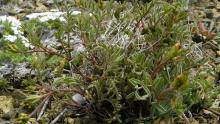
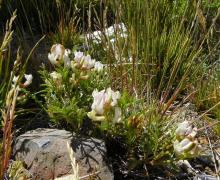
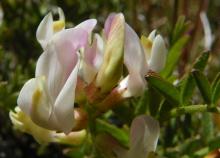
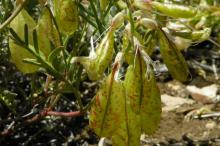
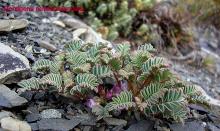
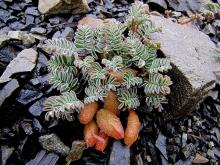
Wow John, what ornamental pods this one has, particularly in your last link showing mottled scarlet pods on Astragalus whitneyi var. sonneanus, a desirable locoweed to search for.